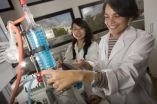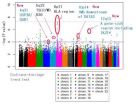(Press-News.org) Replacing gasoline and diesel with plant-based bio fuels is crucial to curb climate change. But there are several ways to transform crops to fuel, and some of the methods result in bio fuels that are harmful to health as well as nature.
Now a study from the University of Copenhagen shows that it is possible to predict just how toxic the fuel will become without producing a single drop. This promises cheaper, faster and above all safer development of alternatives to fossil fuel.
Solvejg Jorgensen is a computational chemist at the Department of Chemistry in Copenhagen. Accounts of her new computational prediction tool are published in acclaimed scientific periodical The Journal of Physical Chemistry A.
Among other things the calculations of the computer chemist show that bio fuels produced by the wrong synthesis path will decompose to compounds such as health hazardous smog, carcinogenic particles and toxic formaldehyde. Previously an assessment of the environmental impact of a given method of production could not be carried out until the fuel had actually been made. Now Jorgensen has shown that various production methods can be tested on the computer. This will almost certainly result in cheaper and safer development of bio fuels.
"There is an almost infinite number of different ways to get to these fuels. We can show the least hazardous avenues to follow and we can do that with a series of calculations that take only days", explains Jorgensen.
Chemically bio fuel is composed of extremely large molecules. As they degrade during combustion and afterwards in the atmosphere they peel of several different compounds. This was no big surprise. That some compounds are more toxic than others did not come as a revelation either but Jorgensen was astonished to learn from her calculations that there is a huge difference in toxicity depending on how the molecules were assembled during production. She was also more than a little pleased that she could calculate very precisely the degradation mechanisms for a bio fuel molecule and do it fast.
"In order to find the best production method a chemist might have to test thousands of different types of synthesis. They just can't wait for a method that takes months to predict the degradation mechanisms", explains Jorgensen who continues: "On the other hand: For a chemist who might spend as much as a year trying to get the synthesis right it would be a disaster if their method leads to a toxic result".
It seems an obvious mission to develop a computational tool that could save thousands of hours in the lab. But Solvejg Jorgensen wasn't really all that interested in bio fuels. What she really wanted to do was to improve existing theoretical models for the degradation of large molecules in the atmosphere.
To this end she needed some physical analysis to compare to her calculations. Colleagues at the Department of Chemistry had just completed the analysis of two bio fuels. One of these would do nicely. But Jorgensen made a mistake. And instead of adding just another piece to a huge puzzle she had laid the foundation for a brand new method.
"I accidentally based my calculations on the wrong molecule, so I had to start over with the right one. This meant I had two different calculations to compare. These should have been almost identical but they were worlds apart. That's when I knew I was on to something important", says Solvejg Jorgensen, who has utilised her intimate knowledge of the theoretical tool density functional theory and the considerable computing power of the University of Copenhagen.
INFORMATION:
The article is published in The Journal of Physical Chemistry A with the title: Atmospheric Chemistry of Two Biodiesel Model Compounds: Methyl Propionate and Ethyl Acetate.
Computational chemistry shows the way to safer biofuels
Mathematical modeling to ensure that climate-friendly alternatives to fossil fuel do not harm health and environment
2011-08-01
ELSE PRESS RELEASES FROM THIS DATE:
Discovery of a new magnetic order
2011-08-01
Physicists at Forschungszentrum Jülich and the universities of Kiel and Hamburg are the first to discover a regular lattice of stable magnetic skyrmions – radial spiral structures made up of atomic-scale spins – on a surface instead of in bulk materials. Such tiny formations could one day form the basis of a new generation of smaller and more efficient data storage units in the field of information technology. The scientists discovered the magnetic spirals, each made up of just 15 atoms, in a one-atomic-layer of iron on iridium. They present their results in the current ...
National asthma genetics consortium releases first results
2011-08-01
A new national collaboration of asthma genetics researchers has revealed a novel gene associated with the disease in African-Americans, according to a new scientific report.
By pooling data from nine independent research groups looking for genes associated with asthma, the newly-created EVE Consortium identified a novel gene association specific to populations of African descent. In addition, the new study confirmed the significance of four gene associations recently reported by a European asthma genetics study.
The findings, published in Nature Genetics, are a promising ...
Physics could be behind the secrets of crop-circle artists
2011-08-01
In this month's edition of Physics World, Richard Taylor, director of the Materials Science Institute at the University of Oregon, takes a serious, objective look at a topic that critics might claim is beyond scientific understanding – crop circles.
As the global crop-circle phenomenon grows alongside advances in science and technology, Taylor notes how physics and the arts are coming together to produce more impressive and spectacular crop-circle patterns that still manage to maintain their mystery.
Today's crop-circle designs are more complex than ever, with some ...
Dissecting the genomes of crop plants to improve breeding potential
2011-08-01
Scientists on the Norwich Research Park, working with colleagues in China, have developed new techniques that will aid the application of genomics to breeding the improved varieties of crop needed to ensure food security in the future. By dissecting the complicated genome of oilseed rape they have been able to produce maps of the genome that are needed for predictive breeding.
Traditional breeding involves crossing two varieties and selecting the best performing among the progeny. Predictive breeding is a more advanced technique where specific parts of the genome most ...
Columbia engineering innovative hand-held lab-on-a-chip could streamline blood testing worldwide
2011-08-01
New York, NY—July 31, 2011—Samuel K. Sia, assistant professor of biomedical engineering at Columbia Engineering, has developed an innovative strategy for an integrated microfluidic-based diagnostic device—in effect, a lab-on-a-chip—that can perform complex laboratory assays, and do so with such simplicity that these tests can be carried out in the most remote regions of the world. In a paper published in Nature Medicine online on July 31, Sia presents the first published field results on how microfluidics—the manipulation of small amounts of fluids—and nanoparticles can ...
Genome-wide study reveals 3 new susceptibility loci for adult asthma in Japanese population
2011-08-01
Researchers at the RIKEN Center for Genomic Medicine (CGM), together with colleagues at Kyoto University, Tsukuba University, Harvard University, and other medical institutions have identified three new loci associated with susceptibility to adult asthma in the Japanese population. The findings appear in Nature Genetics and derive from a genome-wide study of 4836 Japanese individuals.
Around the world, hundreds of millions of people suffer from bronchial asthma, a chronic inflammatory disease characterized by symptoms of wheezing, shortness of breath and coughing. In ...
Researchers discover the mechanism that determines cell position in the intestinal epithelium
2011-08-01
How do cells know where to position themselves and where to accumulate in order to carry out their functions correctly within each organ? Researchers with the Colorectal Cancer Lab at IRB Barcelona have revealed the molecular mechanisms responsible for organizing the intestinal epithelium into distinct comportments, defined by frontiers or territories. The study, headed by Eduard Batlle, coordinator of the Oncology Programme at IRB Barcelona and ICREA Research Professor, is published in today's online version of the Journal Nature Cell Biology, part of the prestigious editorial ...
CSHL scientists reveal mechanism behind 'oncogene addiction' in acute leukemia
2011-08-01
Cold Spring Harbor, NY – A team of scientists at Cold Spring Harbor Laboratory (CSHL) has laid bare the mechanism behind a phenomenon called oncogene addiction in mice suffering from a form of leukemia that mimics acute myelogenous leukemia (AML) in humans. Significantly, the team was able to mobilize their newly gained understanding to target "addiction" pathways in the model mice, resulting in rapid and complete eradication of the cancer, which is usually fatal and resistant to conventional chemotherapy.
Oncogene addiction refers to the curious phenomenon that cancer ...
Physicists show that quantum ignorance is hard to expose
2011-08-01
No-one likes a know-it-all but we expect to be able to catch them out: someone who acts like they know everything but doesn't can always be tripped up with a well-chosen question. Can't they? Not so. New research in quantum physics has shown that a quantum know-it-all could lack information about a subject as a whole, yet answer almost perfectly any question about the subject's parts. The work is published in Physical Review Letters.
"This is something conceptually very weird," says Stephanie Wehner of the Centre for Quantum Technologies at the National University of ...
70 percent of 8-month-olds consume too much salt
2011-08-01
Seventy per cent of eight-month-old babies have a salt (sodium chloride) intake higher than the recommended UK maximum level, due to being fed salty and processed foods like yeast extract, gravy, baked beans and tinned spaghetti.
Many are also given cows' milk, which has higher levels of salt than breast or formula milk, as their main drink despite recommendations that it should not be used in this way until babies are at least one year old. High levels of salt can damage developing kidneys, give children a taste for salty foods and establish poor eating practices that ...
LAST 30 PRESS RELEASES:
Numbers in our sights affect how we perceive space
SIMJ announces global collaborative book project in commemoration of its 75th anniversary
Air pollution exposure and birth weight
Obstructive sleep apnea risk and mental health conditions among older adults
How talking slows eye movements behind the wheel
The Ceramic Society of Japan’s Oxoate Ceramics Research Association launches new international book project
Heart-brain connection: international study reveals the role of the vagus nerve in keeping the heart young
Researchers identify Rb1 as a predictive biomarker for a new therapeutic strategy in some breast cancers
Survey reveals ethical gaps slowing AI adoption in pediatric surgery
Stimulant ADHD medications work differently than thought
AI overestimates how smart people are, according to HSE economists
HSE researchers create genome-wide map of quadruplexes
Scientists boost cell "powerhouses" to burn more calories
Automatic label checking: The missing step in making reliable medical AI
Low daily alcohol intake linked to 50% heightened mouth cancer risk in India
American Meteorological Society announces Rick Spinrad as 2026 President-Elect
Biomass-based carbon capture spotlighted in newly released global climate webinar recording
Illuminating invisible nano pollutants: advanced bioimaging tracks the full journey of emerging nanoscale contaminants in living systems
How does age affect recovery from spinal cord injury?
Novel AI tool offers prognosis for patients with head and neck cancer
Fathers’ microplastic exposure tied to their children’s metabolic problems
Research validates laboratory model for studying high-grade serous ovarian cancer
SIR 2026 delivers transformative breakthroughs in minimally invasive medicine to improve patient care
Stem Cell Reports most downloaded papers of 2025 highlight the breadth and impact of stem cell research
Oxford-led study estimates NHS spends around 3% of its primary and secondary care budget on the health impacts of heat and cold in England
A researcher’s long quest leads to a smart composite breakthrough
Urban wild bees act as “microbial sensors” of city health.
New study finds where you live affects recovery after a hip fracture
Forecasting the impact of fully automated vehicle adoption on US road traffic injuries
Alcohol-related hospitalizations from 2016 to 2022
[Press-News.org] Computational chemistry shows the way to safer biofuelsMathematical modeling to ensure that climate-friendly alternatives to fossil fuel do not harm health and environment


